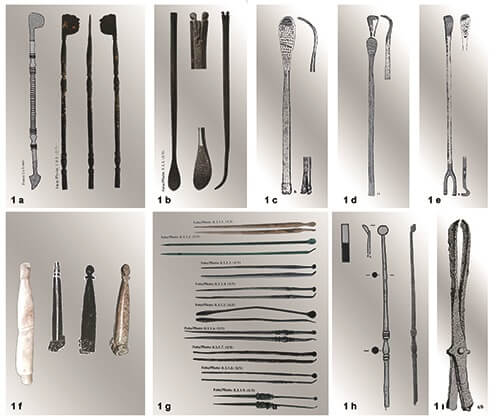
33. Avrupa Üroloji Kongresi, 16-20 Mart 2018 Kopenhag
Guner E. , Guner S.I. , Kalfazade N. , Tugcu V.
University of Health Sciences, Dr. Sadi Konuk Education and Training Hospital, Bakirkoy, Dept. of Urology, Istanbul
Esenyurt University, Kolan International Hospital, Sisli, Dept. of Hematology and Bone Marrow Transplantation, Istanbul
Introduction & Objectives: In ancient times, urethral stricture, phimosis and bladder stones associated with unhealthy conditions, venereal diseases and malnutrition were the most common causes of urination difficulties. In this writing, we discovered the lithotomy tools found in Anatolia in the light of the expressions of ancient doctors and writers.
Materials & Methods: Current literatures and the works of ancient physicians related to surgical treatment of bladder stones and instruments used were researched. The examples of tools used in bladder stone surgeries in archaeological museums have been researched and examined by visit and web based.
Results: In antiquity, various instruments were used in the bladder stones surgery.
Double-sided scalpel: It is probably a long dissection knife described by Galen of Pergamon(129-216AD) and used as a polyp knife, a flephotom, and a lithotome. The notchs on both ends of the bronze body were used with iron knife tips attached (Figure 1a).
Lithotomy scoop with scalpel: Celsus (25BC-50AD) stated that after the perineal incision, the stone that could not be taken with finger was removed with a hook. Rufus of Ephesus (80-150AD) also said that “the stone should be taken with rough inner surface of scoop side”. All expressions showed that the stone was pulled with the curved side of the tool (Figure 1b).
Lithotomy scoop with scalpels found in the grave of Hygenios Kanpylios, the ancient physician of ancient city of Ephesus were published by Kunzl (Figure 1c, d and e).
Lithotomy scoop with hook: Again, the instrument presented by Kunzl one end is in the form of a spoon, while the other end is in the shape of a hook (Figure 1e).
Razor type lithotomy scalpel: In the ancient city of Alianoi, lithotomes have been discovered Razor type in which the knife folded over the bone body (Figure 1f).
Ear scoops: Celcus (25BC-50AD) and Aetius (502-575AD) have stated that ear scoops (probes) are used to remove the urethra stones. An ear scoop was also discovered in Alianoi, believed to have been used for the same purpose (Figure 1g and h).
Lithotomy forceps: Aetius and Paul (625-690AD) stated that if a stone can not be removed with a finger, it should be taken with a forceps. However, in Anatolia a lithotomy forceps like that of the National Archaeological Museum of Naples has not been discovered (Figure 1i).

Conclusions: The narratives of antiquity writers and the instruments discovered were written and visual evidence of lithotomy applications in Anatolia.
1a: Çift taraflı bıçak: Buluntu yeri bilinmiyor, Özel Haluk Perk Müzesi, İstanbul
1b: Neşterli litotomi kaşığı: Buluntu yeri bilinmiyor, Özel Haluk Perk Müzesi, İstanbul
1c,d: Neşterli litotomi kaşığı: Çizim, antikçağ hekimi Hygenios Kanpylios’a ait Efes koleksiyonu, Römisch-Germanisches
Zentralmuseum, Mainz, Almanya
1e: Çengelli Litotomi Kaşığı: Çizim, antikçağ hekimi Hygenios Kanpylios’a ait Efes koleksiyonu, Römisch-Germanisches
Zentralmuseum, Mainz, Almanya
1f: Ustura tarzlı litotomi bıçağı: Alianoi Antik kent buluntusu, Bergama Arkeoloji Müzesi, İzmir
1g: Kulak kaşıkları: Buluntu yeri bilinmiyor, Özel Haluk Perk Müzesi, İstanbul
1h: Kulak kaşığı: Çizim, Alianoi antik kent buluntusu, Bergama Arkeoloji Müzesi, İzmir
1ı: Litotomi forsepsi: Çizim, Pompei antik kent buluntusu, Napoli National Archaeological Museum, İtalya
1a: Double-sided scalpel: Finding place unknown, Haluk Perk Private Museum, Istanbul
1b: Lithotomy scoop with scalpel: Finding place unknown, Haluk Perk Private Museum, Istanbul
1c,d: Lithotomy scoop with scalpel: Drawing, collection of ancient medicine physician Hygenios Kanpylios of Ephesus, Römisch-
Germanisches Zentralmuseum, Mainz, Germany
1e: Lithotomy scoop with hook: Drawing, collection of ancient medicine physician Hygenios Kanpylios of Ephesus, Römisch-
Germanisches Zentralmuseum, Mainz, Germany
1f: Razor type lithotomy scalpel: Finding in Alianoi ancient city, Bergama
Archaeological Museum, Izmir
1g: Ear scoops: Finding place unknown, Haluk Perk Private Museum, Istanbul
1h: Ear scoop: Drawing, finding in Alianoi ancient city, Bergama Archaeological Museum, Izmir
1ı: Lithotomy forceps: Drawing, Finding in Pompei ancient city, Napoli National Archaeological Museum, Italy
Eur Urol Suppl 2018 – Volume 17, Issue (2), Page e263-e264

